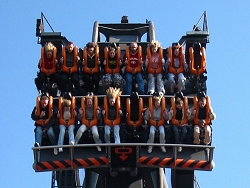|
.
Higher
Capacity Rides
AKA making sure the queues don't appear in the first place
While
Fast Pass, Fastrack, Q-Bot et al are all gimmicks, far and away the best
way of coping with queues is to actually build a high capacity ride to
start with, and not to destroy the virtues of efficiency by installing a
system like Fast Pass.
|

|
| Oblivion
is a triumph against the odds when it comes to capacity |
|
Most
theme parks don’t actually install particularly high capacity rides.
Few Tussauds rides seem to be designed around a particularly high
capacity, and theme parks which are mindful of high counts of people per
hour are certainly in the minority.
In
terms of coasters, 1000pph (people per hour) is the bare minimum at any
discerning theme park. 1200pph is preferable, but anything higher will
keep the queue shuffling along comfortably.
Look
no further than Disney, who are industry leaders in terms of high
capacity roller coasters. Flagship coasters such as California Screamin’
and Paris’ Space Mountain gnaw their way through a meaty 2400pph.
But
even the mighty mouse’s appetite for efficiency is overshadowed by the
travelling German roller coaster.
Bruch’s
Eurostar, for example, is capable of getting through a remarkable
2800pph, which is almost three times that of Rita – Queen of Speed.
And while theme park coasters almost never get close to theoretical
capacities, the same can’t be said of travelling coasters.
So,
how do these coasters manage to get through so many people an hour? And
if it can be done, why aren’t more parks doing it?
Linear
loading is one way, but it has to be applied correctly. Rides using
linear loading include Stealth, Rita – Queen of Speed, Eurostar,
Duelling Dragons and Top Thrill Dragster.
 |
| 1:
Trains approach the station from the left and stop at platform
A and unload.
2:
Train moves forwards empty onto platform B where it is
then loaded. This leaves platform A behind it empty for the
next train to unload.
Stations
using this system:
Eurostar
Rita
– Queen of Speed
Stealth
Grand
National
Oblivion*
Rock
‘N Roller Coaster
Oblivion
uses a similar system, although both trains unload from A and
B simultaneously and then load simultaneously before both
dispatching at the same time.
|
|
There
are several stations – normally two, sometimes more, each with a
specific task, such as unload and load. Stealth and Rita use this system
completely inefficiently, with one station for unload, before the train
moves forward into the loading station.
The
problem is that unloading takes a matter of seconds, while loading is
often the most time consuming part of operating a coaster. On rides as
short as Stealth and Rita, the train spends most of its time in the
stations empty. Indeed, on Stealth, the airgates have only just opened
as the second train has just finished the circuit.
The
benefits of loading like this are questionable, neigh on non-existent.
Tussauds
boasted on their Stealth Minisite that ‘Disney advice isn’t required
at the moment’ saying – basically – that their choice in station
design was down to cost. They couldn’t justify the extra cost of
gates, the switch track and extra labour to operate it.
While
they also cite that they can batch two groups of guests on the platform,
and have streamlined how people deal with loose items such as bags, they
cannot boast that they don’t need Disney advice with a coaster with a
capacity well under half that of one of Disney’s. Continues...
|